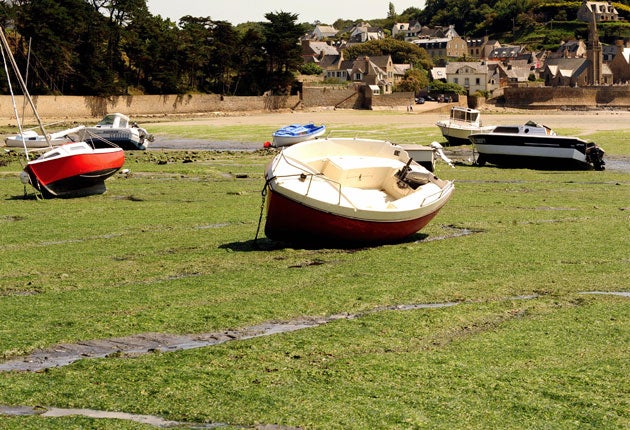Accusations fly over toxic, smelly gas on Brittany's beaches

A chapel stands on a headland above a sandy bay, streaked with slimy green weed. Woodland and scrub descend to the beach's edge. A concrete bunker, built in 1944, awaits the allied invasion that never came (not to this part of France, at least). The Plage de Saint-Maurice could be one of 100 pretty inlets on the north Breton coast – except that, on a sunny August day, there was not a soul walking on the sand, not a single sunbather, not a single child with a bucket or spade. This summer, the beach is the symbol of an ecological calamity which has been 40 years in the making.
Two bored but courteous gendarmes guarded a temporary fence, blocking access to the sand. Past the barrier, below the surface crust of the sand lies an evil-smelling black mud, composed mostly of rotting weed.
An environmental campaigner, Yves-Marie Le Lay, 61, put on his gas mask and stuck his detector into the mud. The machine emitted an angry screech. Mr Le Lay announced that the mud was, in places, approaching the toxic danger threshold for human health.
"We shouldn't be doing this. It should be the government doing this work," he said. "No one is removing all of this filth. Why? It is as if they are waiting for a child to die."
At one end of the Saint Maurice beach, in Saint Brieuc bay, is the mouth of the river Guessant. In the sand and mud of this narrow estuary, 38 wild animal corpses have been discovered since mid-July – a coypu, a badger and 36 wild boar.
This week it was officially confirmed by the French government that the animals had been killed by seaweed. To be precise, autopsies concluded that the animals had died from inhaling hydrogen sulphide, a toxic gas emitted by rotting heaps of ulva, or sea lettuce. Some of the animals had 2.45mg per kilogram of H2S in their lungs – almost double the level needed to kill a human.
The seaweed, always present here in small quantities, has been washing ashore along the Breton coast in great, stinking heaps since the 1970s. Only in the past few years has it been officially admitted that the proliferation of this primitive form of weed has been caused by nitrogen pouring into streams and rivers, and then the sea, from the scores of intensive pig, cattle and maize farms in the heart of the Breton peninsula. In truth, the role of nitrogen pollution is not yet fully admitted. It is denied – against all the scientific evidence – by the farming industry and the powerful agri-pharmaceuticals lobby. They blame global warming or phosphate pollution.
Even the official warning signs on Breton beaches are coy, saying the algues vertes (green weeds) are a "potential danger" but are "naturally present". There is no mention of the nitrogen run-off from Breton farms, which has increased sevenfold since the 1970s. Some progress has been made. More than 1,000 acres of beach was covered in weeds this summer, compared with a peak of more than 2,000 acres in 2008.
But for many days after the animal carcasses were found, farmers' groups claimed that the wild boar had been poisoned, either accidentally or deliberately by ecologists. Farming was not responsible, they said.
The corpse of a poisoned fox was dumped last month on the doorstep of a well-known anti-weed campaigner, André Ollivro. "They say we are anti-farming and we want to destroy the farming industry," Mr Ollivro told i. "We are not anti-farming. But we are against the kind of intensive farming that pours nitrogen fertiliser into the ground or dumps vast quantities of animal effluent."
Join our commenting forum
Join thought-provoking conversations, follow other Independent readers and see their replies
Comments
Bookmark popover
Removed from bookmarks